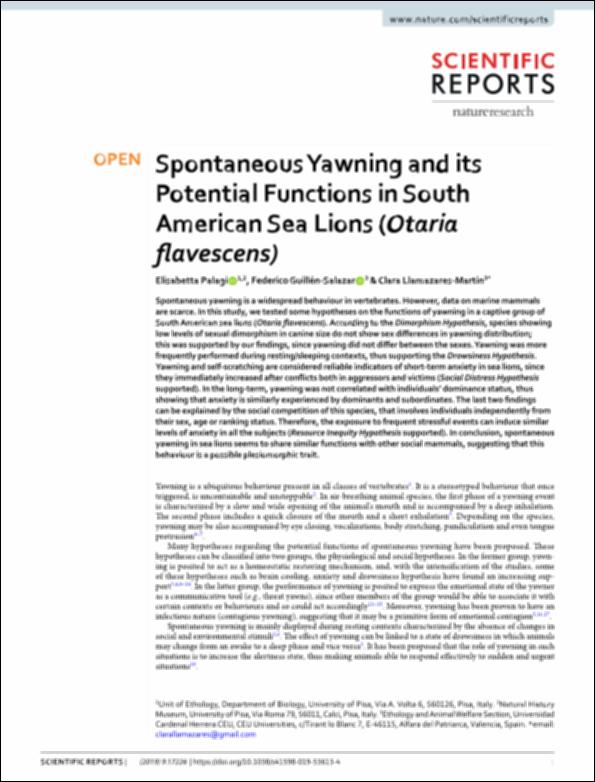Please use this identifier to cite or link to this item:
http://hdl.handle.net/10637/10910Spontaneous yawning and its potential functions in South American sea lions (Otaria flavescens)
| Title: | Spontaneous yawning and its potential functions in South American sea lions (Otaria flavescens) |
| Authors : | Palagi, Elisabetta Guillén Salazar, Federico Llamazares Martín, Clara |
| Keywords: | Etología.; South America sea lions - Behavior.; Pinnipedia - Behavior.; South America sea lions - Social aspects.; Animal behavior.; Leones marinos sudamericanos - Hábitos y conducta.; Leones marinos sudamericanos - Aspectos sociales.; Pinnípedos - Hábitos y conducta. |
| Publisher: | Springer Nature. |
| Citation: | Palagi, E., Guillén-Salazar, F. & Llamazares-Martín, C. (2019). Spontaneous yawning and its potential functions in South American sea lions (Otaria flavescens). Scientific Reports, vol. 9, art. 17226 (21 nov.). DOI: https://doi.org/10.1038/s41598-019-53613-4 |
| Abstract: | Spontaneous yawning is a widespread behaviour in vertebrates. However, data on marine mammals are scarce. In this study, we tested some hypotheses on the functions of yawning in a captive group of South American sea lions (Otaria favescens). According to the Dimorphism Hypothesis, species showing low levels of sexual dimorphism in canine size do not show sex diferences in yawning distribution; this was supported by our fndings, since yawning did not difer between the sexes. Yawning was more frequently performed during resting/sleeping contexts, thus supporting the Drowsiness Hypothesis. Yawning and self-scratching are considered reliable indicators of short-term anxiety in sea lions, since they immediately increased after conficts both in aggressors and victims (Social Distress Hypothesis supported). In the long-term, yawning was not correlated with individuals’ dominance status, thus showing that anxiety is similarly experienced by dominants and subordinates. The last two fndings can be explained by the social competition of this species, that involves individuals independently from their sex, age or ranking status. Therefore, the exposure to frequent stressful events can induce similar levels of anxiety in all the subjects (Resource Inequity Hypothesis supported). In conclusion, spontaneous yawning in sea lions seems to share similar functions with other social mammals, suggesting that this behaviour is a possible plesiomorphic trait. |
| Description: | Este es el artículo que se ha publicado de forma definitiva en: https://www.nature.com/articles/s41598-019-53613-4 |
| URI: | http://hdl.handle.net/10637/10910 |
| Rights : | http://creativecommons.org/licenses/by/4.0/deed.es |
| ISSN: | 2045-2322 (Electrónico). |
| Issue Date: | 21-Nov-2019 |
| Center : | Universidad Cardenal Herrera-CEU |
| Appears in Collections: | Dpto. Producción y Sanidad Animal, Salud Pública Veterinaria y Ciencia y Tecnología de los Alimentos |
Items in DSpace are protected by copyright, with all rights reserved, unless otherwise indicated.


